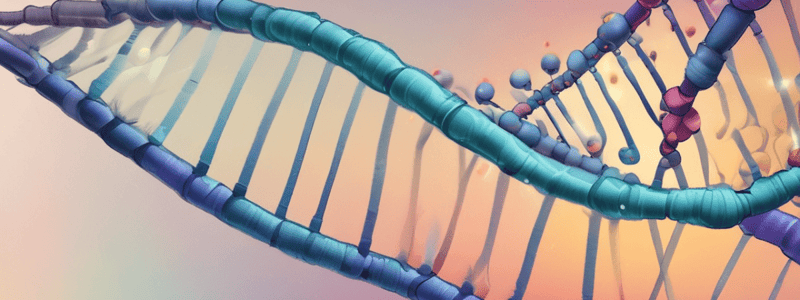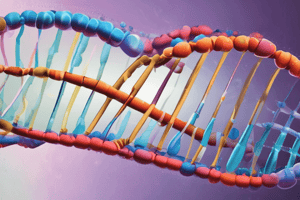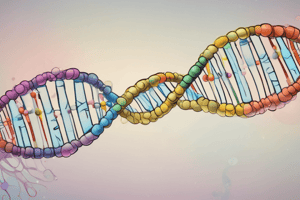Podcast
Questions and Answers
What is a characteristic of DNA replication?
What is a characteristic of DNA replication?
- It is spontaneous, meaning that it occurs without the need for enzymes
- It is unidirectional, meaning that replication occurs in one direction only
- It is semiconservative, meaning that each new DNA molecule contains one original strand and one new strand (correct)
- It is conservative, meaning that the original DNA molecule is preserved
What is the function of specific proteins in initiation of DNA replication?
What is the function of specific proteins in initiation of DNA replication?
- To recognize and bind to the origin of replication (correct)
- To proofread the newly synthesized DNA
- To unwind the double helix
- To synthesize new DNA strands
What is the term for the point at which the replication process is occurring?
What is the term for the point at which the replication process is occurring?
- Replication origin
- Replication molecule
- Replication fork (correct)
- Replication enzyme
What is the result of DNA replication?
What is the result of DNA replication?
What is the direction of DNA replication in bacteria?
What is the direction of DNA replication in bacteria?
What is the function of the origin of replication?
What is the function of the origin of replication?
What is the composition of each new DNA molecule after replication?
What is the composition of each new DNA molecule after replication?
What is the name of the process by which DNA replication occurs?
What is the name of the process by which DNA replication occurs?
What is necessary before DNA synthesis can begin on the lagging strand?
What is necessary before DNA synthesis can begin on the lagging strand?
Why are Okazaki fragments formed during DNA replication?
Why are Okazaki fragments formed during DNA replication?
What is the role of DNA polymerase in Okazaki fragment synthesis?
What is the role of DNA polymerase in Okazaki fragment synthesis?
What is the function of DNA ligase during DNA replication?
What is the function of DNA ligase during DNA replication?
What is the result of the replication of a circular bacterial chromosome?
What is the result of the replication of a circular bacterial chromosome?
What is the time it takes for the replication of the E. coli chromosome?
What is the time it takes for the replication of the E. coli chromosome?
What event occurs when the two replication forks meet during DNA replication?
What event occurs when the two replication forks meet during DNA replication?
Which enzyme is responsible for reinitiating synthesis on the lagging strand?
Which enzyme is responsible for reinitiating synthesis on the lagging strand?
What is the primary function of ribosomes?
What is the primary function of ribosomes?
What type of bond is formed between two amino acids during protein synthesis?
What type of bond is formed between two amino acids during protein synthesis?
What do ribosomes locate on the mRNA molecule?
What do ribosomes locate on the mRNA molecule?
What is the result of protein synthesis in ribosomes?
What is the result of protein synthesis in ribosomes?
Where do ribosomes bind to the mRNA molecule?
Where do ribosomes bind to the mRNA molecule?
What is the role of the start codon in protein synthesis?
What is the role of the start codon in protein synthesis?
What is the role of mRNA?
What is the role of mRNA?
What happens when RNA polymerase encounters a terminator?
What happens when RNA polymerase encounters a terminator?
What is the function of the genetic code?
What is the function of the genetic code?
What is the number of different codons possible in the genetic code?
What is the number of different codons possible in the genetic code?
What is translation?
What is translation?
What is the result of a single gene being transcribed repeatedly?
What is the result of a single gene being transcribed repeatedly?
What is the composition of proteins?
What is the composition of proteins?
What is the term for a sequence of three nucleotides?
What is the term for a sequence of three nucleotides?
What is the primary function of a tRNA molecule?
What is the primary function of a tRNA molecule?
What is the role of the anticodon in a tRNA molecule?
What is the role of the anticodon in a tRNA molecule?
What is the result of the interaction between a tRNA and the mRNA codon?
What is the result of the interaction between a tRNA and the mRNA codon?
What is the function of the P-site in the ribosome?
What is the function of the P-site in the ribosome?
What is the function of the rRNA in the ribosome?
What is the function of the rRNA in the ribosome?
What determines the sequence of amino acids in a protein?
What determines the sequence of amino acids in a protein?
What is the role of the AUG codon in translation?
What is the role of the AUG codon in translation?
What is the result of peptide bond formation between two amino acids?
What is the result of peptide bond formation between two amino acids?
What is the direction of RNA synthesis during transcription?
What is the direction of RNA synthesis during transcription?
What is the role of sigma factor during transcription?
What is the role of sigma factor during transcription?
What happens to the sigma factor during elongation?
What happens to the sigma factor during elongation?
What is the region of DNA where RNA polymerase binds?
What is the region of DNA where RNA polymerase binds?
What is the result of RNA polymerase binding to the promoter?
What is the result of RNA polymerase binding to the promoter?
What is the function of RNA polymerase during transcription?
What is the function of RNA polymerase during transcription?
What is the template strand during transcription?
What is the template strand during transcription?
What is the purpose of the promoter region during transcription?
What is the purpose of the promoter region during transcription?
In which direction is RNA synthesized?
In which direction is RNA synthesized?
What happens to RNA polymerase when it encounters a terminator?
What happens to RNA polymerase when it encounters a terminator?
What is the location of the promoter in relation to the RNA?
What is the location of the promoter in relation to the RNA?
What is the role of RNA polymerase in RNA synthesis?
What is the role of RNA polymerase in RNA synthesis?
What is the sequence of events during RNA synthesis?
What is the sequence of events during RNA synthesis?
What is the function of the 5' end of the RNA?
What is the function of the 5' end of the RNA?
What happens to the RNA polymerase after RNA synthesis is complete?
What happens to the RNA polymerase after RNA synthesis is complete?
What is the role of the 3' end of the RNA during synthesis?
What is the role of the 3' end of the RNA during synthesis?
Which component of the bacterial RNA polymerase recognizes the promoter?
Which component of the bacterial RNA polymerase recognizes the promoter?
What is the role of transcription factors in eukaryotic cells and archaea?
What is the role of transcription factors in eukaryotic cells and archaea?
What is the function of the sigma subunit in bacterial RNA polymerase?
What is the function of the sigma subunit in bacterial RNA polymerase?
Which of the following is NOT a characteristic of RNA polymerase in eukaryotic cells and archaea?
Which of the following is NOT a characteristic of RNA polymerase in eukaryotic cells and archaea?
What is the direction of nucleotide addition during RNA synthesis?
What is the direction of nucleotide addition during RNA synthesis?
What is the energy source for RNA synthesis?
What is the energy source for RNA synthesis?
What type of immune response involves the generation of antibodies reactive with a particular antigen?
What type of immune response involves the generation of antibodies reactive with a particular antigen?
What is the role of B cells in the immune response?
What is the role of B cells in the immune response?
What is the developmental pathway of B cells dependent on?
What is the developmental pathway of B cells dependent on?
What is the role of dendritic cells in the immune response?
What is the role of dendritic cells in the immune response?
What is the result of the effector phase of the immune response?
What is the result of the effector phase of the immune response?
What is the characteristic of cellular immune responses?
What is the characteristic of cellular immune responses?
What is the result of immunodeficiency?
What is the result of immunodeficiency?
What is the term for the lymphocytes responsible for cellular immune responses?
What is the term for the lymphocytes responsible for cellular immune responses?
Which IgM molecule feature is critical for activation of the classical pathway?
Which IgM molecule feature is critical for activation of the classical pathway?
What is the final result of the lytic pathway of the complement system?
What is the final result of the lytic pathway of the complement system?
Which immune cells are capable of antibody-dependent cellular cytotoxicity (ADCC)?
Which immune cells are capable of antibody-dependent cellular cytotoxicity (ADCC)?
What is required to trigger low-affinity FcγRIII receptors?
What is required to trigger low-affinity FcγRIII receptors?
Which immunoglobulin isoforms do not activate the classical pathway?
Which immunoglobulin isoforms do not activate the classical pathway?
What is the role of C1q in the classical pathway?
What is the role of C1q in the classical pathway?
What is the result of the convergence of all pathways in the complement system?
What is the result of the convergence of all pathways in the complement system?
What is the common feature of the Fc regions of IgM molecules that allows for efficient activation of C1q?
What is the common feature of the Fc regions of IgM molecules that allows for efficient activation of C1q?
Where are natural killer cells thought to develop?
Where are natural killer cells thought to develop?
What type of molecules carry messages between cells in the immune response?
What type of molecules carry messages between cells in the immune response?
What type of receptors recognize conserved microbial structures directly?
What type of receptors recognize conserved microbial structures directly?
What is the result of high doses of antigen on the immune response?
What is the result of high doses of antigen on the immune response?
What is the route of entry for an antigen that leads to a response in the spleen?
What is the route of entry for an antigen that leads to a response in the spleen?
What type of molecules are recognized by the innate immune system?
What type of molecules are recognized by the innate immune system?
What is the function of toll-like receptors?
What is the function of toll-like receptors?
What is the result of moderate doses of antigen on the immune response?
What is the result of moderate doses of antigen on the immune response?
Flashcards are hidden until you start studying
Study Notes
DNA Replication
- DNA replication is semiconservative, meaning each new molecule contains one original strand paired with a newly synthesized strand.
- Replication forks are formed at the origin of replication, and the process is bidirectional.
Initiation of DNA Replication
- Specific proteins recognize and bind to the origin of replication to initiate DNA synthesis.
- An RNA primer is made first, and then DNA polymerase adds nucleotides to the end of the primer.
- The result is a series of small fragments called Okazaki fragments, each with a short stretch of RNA at one end.
Synthesis of the Lagging Strand
- Discontinuous synthesis generates Okazaki fragments.
- DNA polymerase adds nucleotides to the end of one Okazaki fragment, eventually reaching the end of another.
- Another DNA polymerase then removes the RNA primer nucleotides and replaces them with deoxynucleotides.
- The enzyme DNA ligase seals the gaps between fragments by forming a covalent bond.
Termination of Transcription
- Transcription is terminated when RNA polymerase encounters a sequence called a terminator.
- The enzyme falls off the DNA template and releases the newly synthesized RNA.
Translation
- Translation is the process of decoding the information carried in mRNA to synthesize a protein.
- Ribosomes serve as translation "machines" that string amino acids together to make a polypeptide.
- tRNAs carry an amino acid to be used in translation and recognize specific codons in the mRNA.
The Role of mRNA
- mRNA is a temporary copy of the information in DNA, carrying encoded instructions for synthesis of a specific protein.
- The information in mRNA must be decoded into amino acids using the genetic code.
The Genetic Code
- The genetic code correlates a series of three nucleotides, a codon, with one amino acid.
- There are 64 different codons, and three are stop codons.
- The genetic code is practically universal, meaning it is used by all living things with a few minor changes.
The Role of Ribosomes
- Ribosomes locate key punctuation sequences on the mRNA molecule, such as the points at which protein synthesis should begin.
- Ribosomes have two sites, the P-site and the A-site, where amino acid-carrying tRNAs can bind.
Elongation of the Polypeptide Chain
- At the start of translation, the initiating tRNA carrying the f-Met occupies the P-site.
- A tRNA that recognizes the next codon on the mRNA then fills the unoccupied A-site.
- Once both sites are filled, an rRNA creates a peptide bond between the two amino acids carried by the tRNAs.
RNA Synthesis Process
- RNA polymerase binds to the promoter and melts a short stretch of DNA, and the template strand is used to synthesize a single-stranded RNA molecule.
- Sigma factor dissociates from RNA polymerase during elongation, leaving the core enzyme to complete transcription.
RNA Polymerase Structure and Function
- RNA polymerase has a loosely attached subunit called sigma (s) factor that recognizes the promoter.
- Cells can produce various types of s factors, each recognizing different promoters.
- Controlling which s factors are made allows cells to transcribe specialized sets of genes as needed.
Eukaryotic and Archaeal RNA Polymerases
- RNA polymerases of eukaryotic cells and archaea use proteins called transcription factors to recognize promoters.
Transcription Process
- RNA is synthesized in the 5' to 3' direction as the enzyme adds nucleotides to the 3' end of the growing chain.
- Nucleotides are added only to the 3' end, and the reaction is fueled by hydrolyzing a high-energy phosphate bond of the incoming nucleotide.
Initiation
- RNA polymerase binds to the promoter and melts a short stretch of DNA during initiation.
Elongation
- RNA polymerase denatures a new stretch of DNA and allows the previous portion to renature during elongation.
- This exposes a new region of the template so elongation can continue.
Termination
- When RNA polymerase encounters a terminator, it falls off the template and releases the newly synthesized RNA.
- RNA polymerase dissociates from the template after termination.
Humoral and Cellular Immune Responses
- Humoral responses result in the generation of antibodies reactive with a particular antigen
- Antibodies are proteins with similar structures, known collectively as immunoglobulins (Ig)
- Adaptive humoral responses can be transferred passively to another individual by injection of serum
- Cellular immune responses are dependent on an intact thymus, and the lymphocytes responsible are known as thymus-dependent (T) cells
B Cells and T Cells
- Antibody-producing lymphocytes, dependent on the bone marrow, are known as B cells
- In response to antigen stimulation, B cells will mature to antibody-secreting plasma cells
- T cells are responsible for cellular immune responses and are dependent on an intact thymus
Recognition Phase
- The recognition phase is common to both adaptive and innate immunity
- It involves professional cells, known as classical dendritic cells, that recognize general pathogen features or specific antigenic molecules
- Dendritic cells process antigens and present antigen fragments to other cells of the immune system
Effector Phase
- In the effector phase, neutrophils and macrophages (innate immunity) and antibodies and effector T lymphocytes (adaptive immunity) eliminate the antigen
Immune System Diseases
- The immune system may fail (immunodeficiency), become malignant (lymphoid malignancies), or produce aberrant responses (such as in autoimmunity or allergy)
Effector Mechanisms
- Effector mechanisms are often dependent on messages from initiating or regulating cells
- Soluble mediators, which carry messages between cells, are known as interleukins, cytokines, and chemokines
Molecules Recognized by Immune Systems
- Foreign substances are recognized by both the innate and adaptive systems, but in different ways, using different receptors
- The innate system is activated by ‘danger signals’, due to pattern recognition receptors (PRRs) on dendritic cells recognizing conserved microbial structures directly
Factors Influencing the Immune Response
- The nature of the molecule (protein content, size, solubility) influences the immune response
- The dose of the antigen influences the immune response, with low doses provoking small amounts of antibody with high affinity and restricted specificity
- The route of entry of the antigen influences the immune response, with different routes leading to different immune responses
Studying That Suits You
Use AI to generate personalized quizzes and flashcards to suit your learning preferences.




